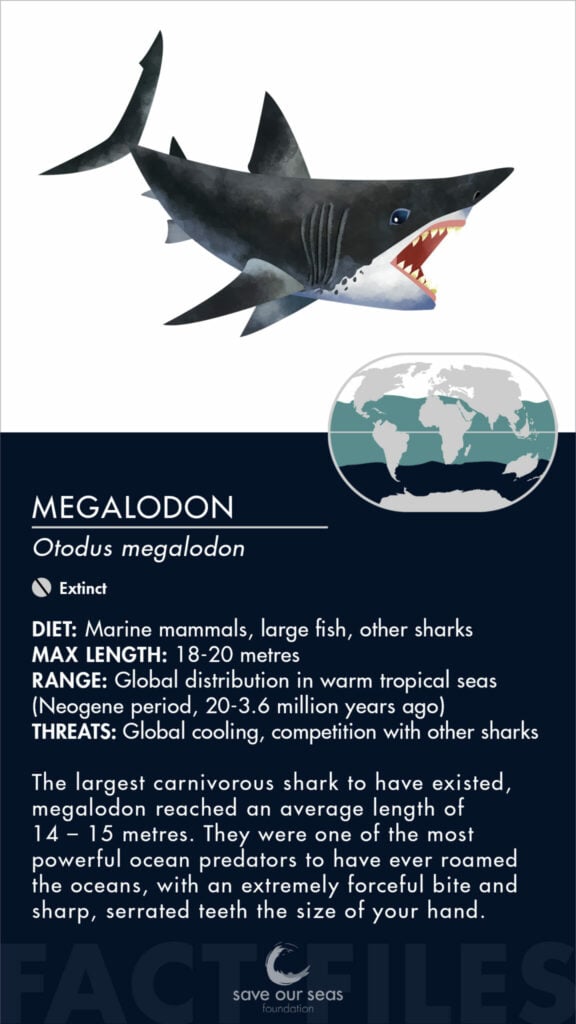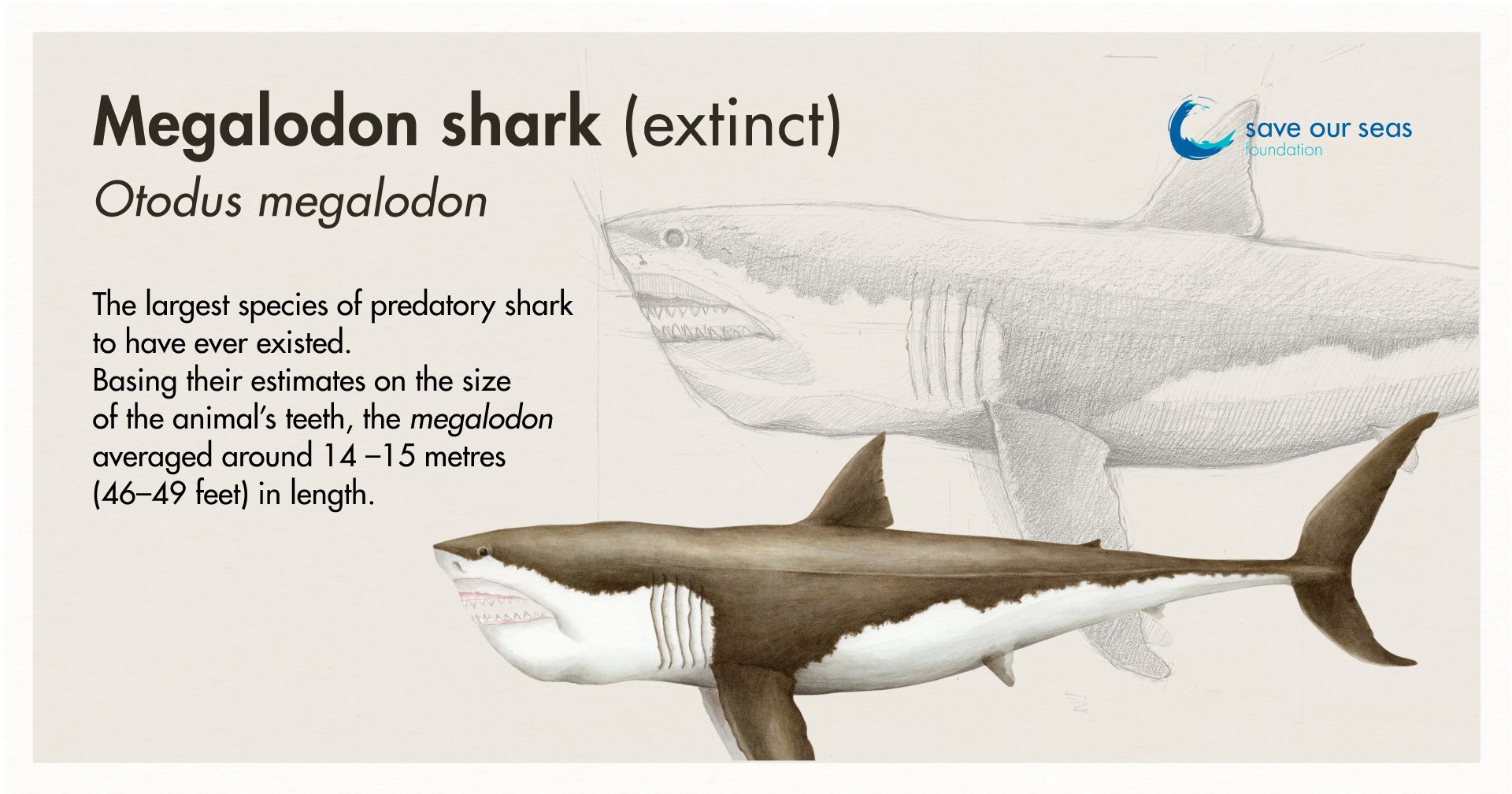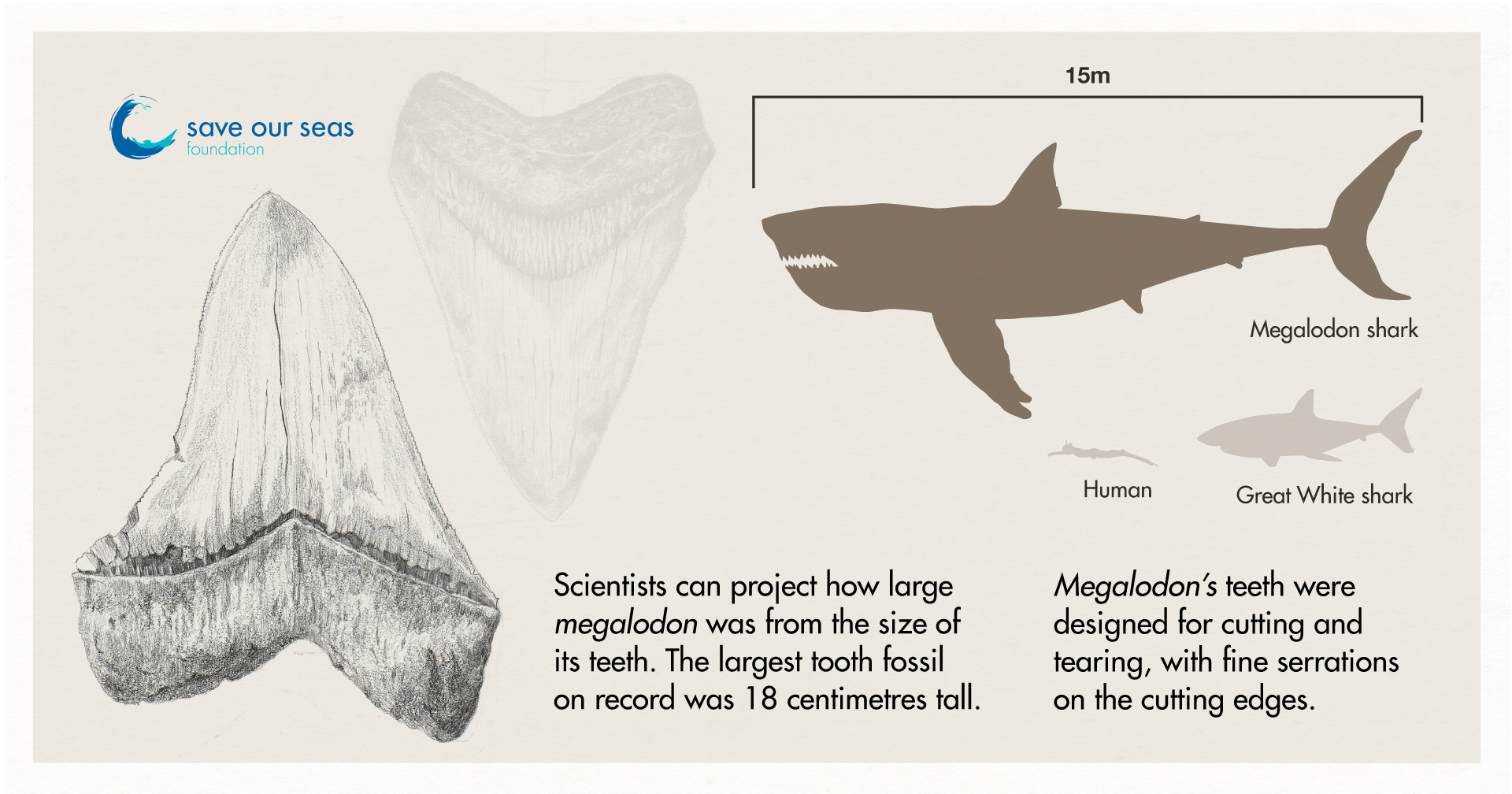Megalodon
Otodus megalodon
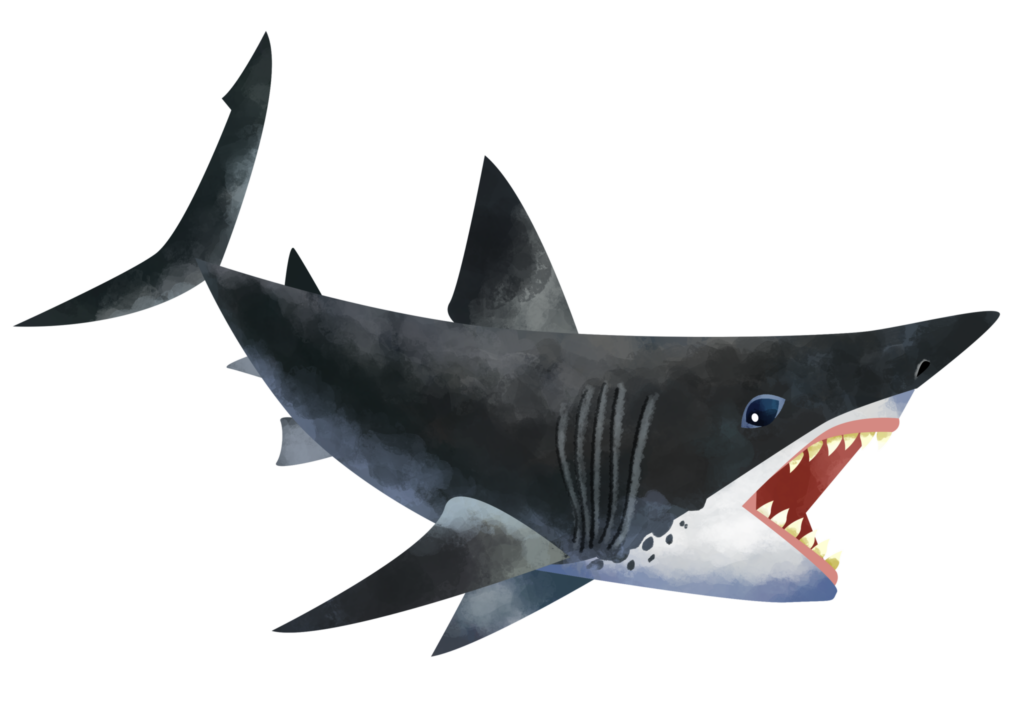

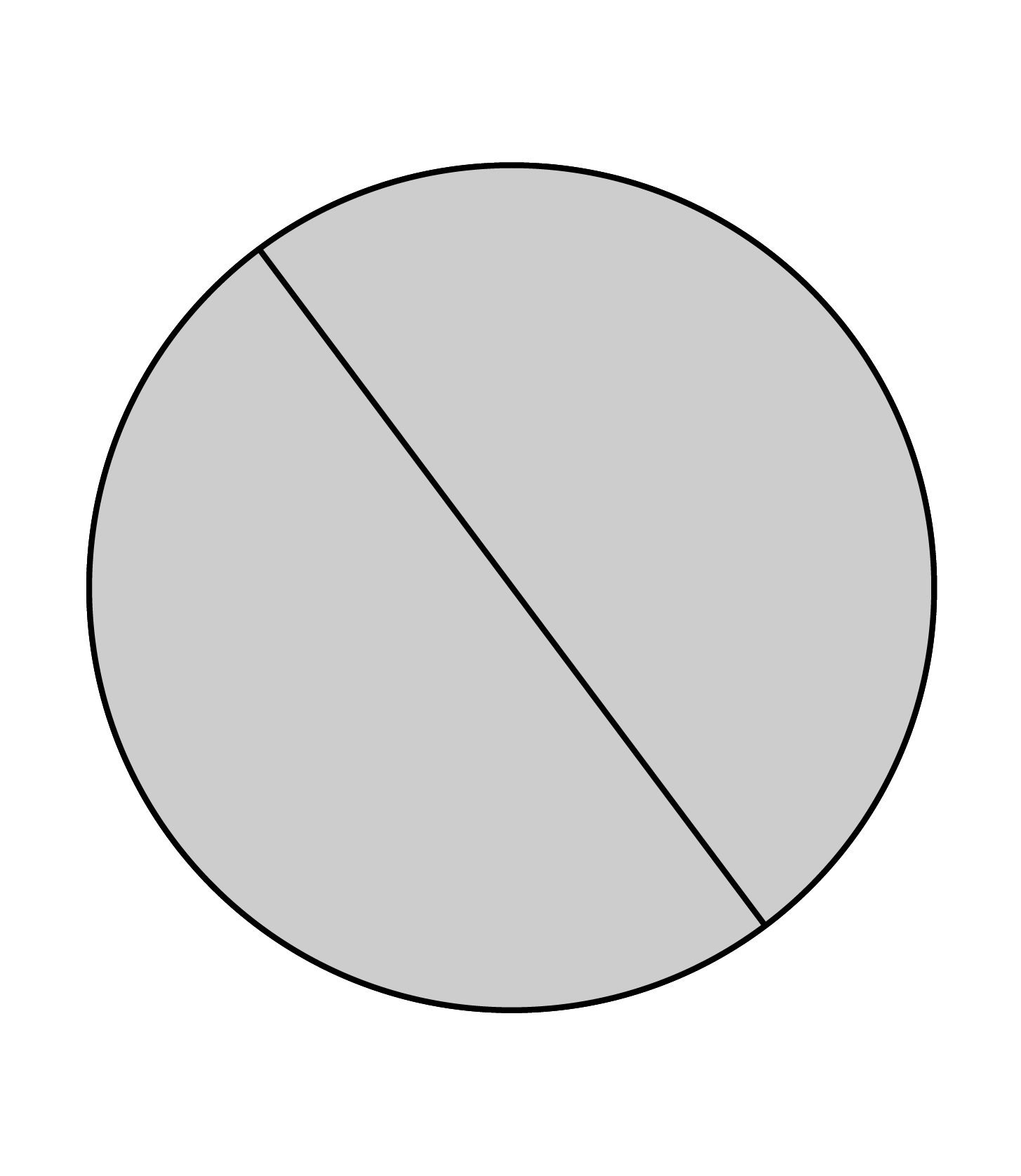
The only reason we know of this gigantic predator is because of all the massive teeth they left behind, and the scars left by those teeth on the bones of large, prehistoric whales. The last member of the megatooth lineage, megalodon roamed the seas of the middle Miocene to the end of the Pliocene, becoming extinct around 3.6 million years ago.

Identification
Although it is hard to know for certain, it is thought that megalodon had a similar body shape to other sharks in its order, Lamniformes, the mackerel sharks. They had a blunt rostrum, a flat jaw and possibly long pectoral fins (like blue sharks) to support it’s immense weight and size. For some time, it was a popular theory that megalodon was related to great white sharks and so many reconstructions depict them as an enormous version of the great white, but this has now been proven to be incorrect – the megalodon comes from an entirely different lineage and likely looked different to the great white.
Special Behaviour
As the most powerful ocean predator to have ever existed, megalodon was an active hunter of large whales. Tooth marks on the tail and fin bones of whales show tooth marks, and suggest megalodon attempted to immobilise its prey before feeding.
Reproduction
Very little is known about the reproduction and life history of megalodon. From similar species and estimates of its lifespan, scientists believe that megalodon was slow to reproduce and took a long time to reach maturity. Collections of juvenile teeth at certain sites – like the Gatun Formation in Panama – imply these sharks had nursery grounds in shallower waters, like modern day sharks. Analysis of these teeth also suggest that megalodon had the largest neonate size of any shark species, of up to 2 metres in total length.
Habitat and Geographical Range
Megalodon teeth have been found on every continent except Antarctica, showing they had a global distribution. It is thought they were adapted to tropical and sub-tropical waters with warmer temperatures.

Diet Description
Megalodon preyed on large whales, fish and other sharks. It was an apex predator.
Threats
It is thought that megalodon went extinct because of global cooling. As the sea temperatures cooled, megalodon would have lost suitable habitat and prey, and its range would have shrunk dramatically as it was limited by its warm water niche. Equally, ice forming at the poles and lowering sea levels would have destroyed nursery areas.
Some scientists believe that megalodon was also in competition with other sharks, including the ancestor of the great white.
Relationships with Humans
Megalodon went extinct long before humans arrived on the scene. The latest known fossil is dated to 3.6 million years ago – our own species, Homo sapiens, showed up just 300, 000 years ago. However, humans have long retained a fascination for megalodon, and they are the feature of many documentaries and films.
Fun Facts
Scientists estimate megalodon had a bite force of 108, 514 – 182, 201 Newtons (N) – that’s 3 times stronger than t-rex, and a whopping 10 times that of a great white!
Much of what we know comes from their teeth, as sharks have cartilaginous skeletons that do not easily fossilise. Just one reasonably preserved megalodon vertebral column exists, and it’s the size of a dinner plate!
The largest tooth ever found is about 18cm in height.
Megalodon could open its jaw 2.7 – 3.4 metres wide: that’s enough to fit two adult humans inside!
Two of the best places to find megalodon teeth is Carolina and Florida – this is because they used to be submerged during the Miocene when megalodon roamed the seas, and would have actually been a prehistoric seafloor!
Want more? Head over to the Megalodon Topic for more on this incredible prehistoric shark species.
References
Herraiz, J.L., Ribé, J., Botella, H., Martínez-Pérez, C. and Ferrón, H.G., 2020. Use of nursery areas by the extinct megatooth shark Otodus megalodon (Chondrichthyes: Lamniformes). Biology letters, 16(11), p.20200746.
Pimiento, C. and Balk, M.A., 2015. Body-size trends of the extinct giant shark Carcharocles megalodon: a deep-time perspective on marine apex predators. Paleobiology, 41(3), pp.479-490
Cooper, J.A., Pimiento, C., Ferrón, H.G. and Benton, M.J., 2020. Body dimensions of the extinct giant shark Otodus megalodon: a 2D reconstruction. Scientific reports, 10(1), pp.1-9.
Wroe, S., Huber, D.R., Lowry, M., McHenry, C., Moreno, K., Clausen, P., Ferrara, T.L., Cunningham, E., Dean, M.N. and Summers, A.P., 2008. Three‐dimensional computer analysis of white shark jaw mechanics: how hard can a great white bite?. Journal of Zoology, 276(4), pp.336-342.
Pimiento, C., Ehret, D.J., MacFadden, B.J. and Hubbell, G., 2010. Ancient nursery area for the extinct giant shark Megalodon from the Miocene of Panama. PLoS one, 5(5), p.e10552.
Shimada, K., 2021. The size of the megatooth shark, Otodus megalodon (Lamniformes: Otodontidae), revisited. Historical Biology, 33(7), pp.904-911.
